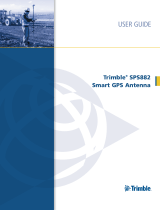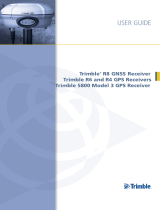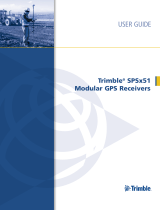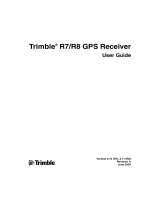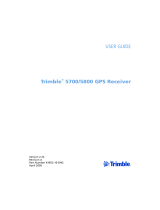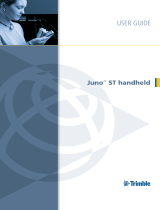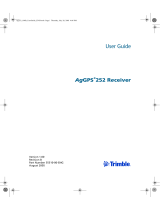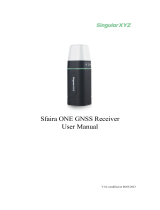Page is loading ...

Version 4.60
Revision A
June 2012
1
GETTING STARTED GUIDE
Trimble SPS855 GNSS Receiver
1

Corporate Office
Trimble Navigation Limited
935 Stewart Drive
Sunnyvale, CA 94085
USA
www.trimble.com
Heavy Highway business area
Trimble Navigation Limited
Heavy Highway business area
5475 Kellenburger Road
Dayton, Ohio 45424-1099
USA
800-538-7800 (toll free in USA)
+1-937-245-5600 Phone
+1-937-233-9004 Fax
www.trimble.com
Email: trimble_support@trimble.com
Legal Notices
© 2006–2012, Trimble Navigation Limited. All rights reserved.
Trimble, and the Globe & Triangle logo are trademarks of Trimble
Navigation Limited, registered in the United States and in other
countries. AutoBase, CMR, CMR+, Connected Community, EVEREST,
HYDROpro, Maxwell, Micro-Centered, Trimble Geomatics Office,
SiteNet, TRIMMARK, TRIMTALK, TSCe, VRS, Zephyr, and Zephyr
Geodetic are trademarks of Trimble Navigation Limited.
Microsoft, Windows, and Windows Vista are either registered
trademarks or trademarks of Microsoft Corporation in the United States
and/or other countries.
The Bluetooth word mark and logos are owned by the Bluetooth SIG,
Inc. and any use of such marks by Trimble Navigation Limited is under
license.
All other trademarks are the property of their respective owners.
Support for Galileo is developed under a license of the European Union
and the European Space Agency (SPS985/SPS855/SPS555H).
NTP Software Copyright
© David L. Mills 1992-2009. Permission to use, copy, modify, and
distribute this software andits documentation for any purpose with or
without fee is herebygranted, provided that the above copyright notice
appears in allcopies and that both the copyright notice and this
permissionnotice appear in supporting documentation, and that the
name University of Delaware not be used in advertising or publicity
pertaining to distribution of the software without specific,written prior
permission. The University of Delaware makes no representations about
the suitability this software for any purpose. It is provided "as is" without
express or implied warranty.
Release Notice
This is the April 2012 release (Revision A) of the SPS Modular Receiver
documentation. It applies to version 4.60 of the receiver firmware.
Product Limited Warranty Information
For applicable product Limited Warranty information, please refer to the
Limited Warranty Card included with this Trimble product, or consult your
local Trimble authorized dealer.
COCOM limits
This notice applies to the SPS351, SPS555H, SPSx61, SPS855, and
SPS985 receivers.
The U.S. Department of Commerce requires that all exportable GPS
products contain performance limitations so that they cannot be used in
a manner that could threaten the security of the United States. The
following limitations are implemented on this product:
– Immediate access to satellite measurements and navigation results is
disabled when the receiver velocity is computed to be greater than
1,000 knots, or its altitude is computed to be above 18,000 meters. The
receiver GPS subsystem resets until the COCOM situation clears. As a
result, all logging and stream configurations stop until the GPS
subsystem is cleared.
Notices
Class B Statement – Notice to Users. This equipment has been
tested and found to comply with the limits for a Class B digital device
pursuant to Part 15 of the FCC Rules. Some equipment configurations
include an optional 410 MHz to 470 MHz UHF radio transceiver module
compliant with Part 90. These limits are designed to provide reasonable
protection against harmful interference in a residential installation. This
equipment generates, uses, and can radiate radio frequency energy and,
if not installed and used in accordance with the instructions, may cause
harmful interference to radio communication. However, there is no
guarantee that interference will not occur in a particular installation. If
this equipment does cause harmful interference to radio or television
reception, which can be determined by turning the equipment off and
on, the user is encouraged to try to correct the interference by one or
more of the following measures:
– Increase the separation between the equipment and the receiver.
– Connect the equipment into an outlet on a circuit different from that to
which the receiver is connected.
– Consult the dealer or an experienced radio/TV technician for help.
Changes and modifications not expressly approved by the manufacturer
or registrant of this equipment can void your authority to operate this
equipment under Federal Communications Commission rules.
This equipment must be installed and operated in accordance with
provided instructions and the antenna(s) used for this transmitter must
be installed to provide a separation distance of at least 20 cm from all
persons and must not be co-located or operated in conjunction with any
other antenna or transmitters (except in accordance with the FCC multi -
transmitter product procedures).
Canada
This Class B digital apparatus complies with Canadian ICES-003.
Cet appareil numérique de la classe B est conforme à la norme NMB-003
du Canada.
This apparatus complies with Canadian RSS-GEN, RSS-310, RSS-210, and
RSS-119.
Cet appareil est conforme à la norme CNR-GEN, CNR-310, CNR-210, et
CNR-119 du Canada.
Europe
The product covered by this guide are intended to be
used in all EU member countries, Norway, and
Switzerland. Products been tested and found to comply
with the requirements for a Class B device pursuant to
European Council Directive 89/336/EEC on EMC, thereby satisfying the
requirements for CE Marking and sale within the European Economic
Area (EEA). Contains a Bluetooth radio module. These requirements are
designed to provide reasonable protection against harmful interference
when the equipment is operated in a residential or commercial
environment. The 450 MHZ (PMR) bands and 2.4 GHz are non-
harmonized throughout Europe.
CE Declaration of Conformity
Hereby, Trimble Navigation, declares that the GPS receivers are in
compliance with the essential requirements and other relevant
provisions of Directive 1999/5/EC.
Australia and New Zealand
This product conforms with the regulatory requirements of
the Australian Communications and Media Authority
(ACMA) EMC framework, thus satisfying the
requirements for C-Tick Marking and sale within Australia
and New Zealand.
Restriction of Use of Certain Hazardous Substances in Electrical
and Electronic Equipment (RoHS)
Trimble products in this guide comply in all material respects with
DIRECTIVE 2002/95/EC OF THE EUROPEAN PARLIAMENT AND OF THE
COUNCIL of 27 January 2003 on the restriction of the use of certain
hazardous substances in electrical and electronic equipment (RoHS
Directive) and Amendment 2005/618/EC filed under C(2005) 3143, with
exemptions for lead in solder pursuant to Paragraph 7 of the Annex to
the RoHS Directive applied.
Waste Electrical and Electronic Equipment (WEEE)
For product recycling instructions and more information,
please go to www.trimble.com/ev.shtml.
Recycling in Europe: To recycle Trimble WEEE (Waste
Electrical and Electronic Equipment, products that run on
electrical power.), Call +31 497 53 24 30, and ask for the
“WEEE Associate”. Or, mail a request for recycling
instructions to:
Trimble Europe BV
SPS855 GNSS Modular Receiver Getting Started Guide 2

c/o Menlo Worldwide Logistics
Meerheide 45
5521 DZ Eersel, NL
Unlicensed radios in products
This device complies with part 15 of the FCC Rules.
Operation is subject to the following two conditions:
(1) This device may not cause harmful interference, and
(2) This device must accept any interference received, including
interference that may cause undesired operation.
Licensed radios in products
This device complies with part 15 of the FCC Rules.
Operation is subject to the condition that this device may not cause
harmful interference.
SPS855 GNSS Modular Receiver Getting Started Guide 3

Safety Information
Before you use your Trimble product, make sure that you have read and understood all safety
requirements.
WARNING – This alert warns of a potential hazard which, if not avoided, could result in severe injury or even
death.
CAUTION – This alert warns of a potential hazard or unsafe practice that could result in minor injury or property
damage or irretrievable data loss.
Note – An absence of specific alerts does not mean that there are no safety risks involved.
Use and care
This product is designed to withstand the rough treatment and tough environment that typically
occurs in construction applications. However, the receiver is a high-precision electronic instrument
and should be treated with reasonable care.
CAUTION – Operating or storing the receiver outside the specified temperature range can damage it.
Regulations and safety
Some receiver models with base station capability contain an internal radio-modem for
transmission or can transmit through an external data communications radio. Regulations
regarding the use of the 410 MHz to 470 MHz radio-modems vary greatly from country to country.
In some countries, the unit can be used without obtaining an end-user license. Other countries
require end-user licensing. For licensing information, consult your local Trimble dealer.
All Trimble receiver models described in this documentation are capable of transmitting data
through Bluetooth wireless technology.
Bluetooth wireless technology, and 900 MHz radio-modems operate in license-free bands.
Note – 900 MHz radios are not used in Europe.
Before operating a Trimble receiver or GSM modem, determine if authorization or a license to
operate the unit is required in your country. It is the responsibility of the end user to obtain an
operator's permit or license for the receiver for the location or country of use.
For FCC regulations, see Notices.
Type approval
Type approval, or acceptance, covers technical parameters of the equipment related to emissions
that can cause interference. Type approval is granted to the manufacturer of the transmission
equipment, independent from the operation or licensing of the units. Some countries have unique
technical requirements for operation in particular radio-modem frequency bands. To comply with
those requirements, Trimble may have modified your equipment to be granted Type approval.
SPS855 GNSS Modular Receiver Getting Started Guide 4

Unauthorized modification of the units voids the Type approval, the warranty, and the operational
license of the equipment.
Exposure to radio frequency radiation
For 450 MHz radio
Safety. Exposure to RF energy is an important safety consideration. The FCC has adopted a safety
standard for human exposure to radio frequency electromagnetic energy emitted by FCC regulated
equipment as a result of its actions in General Docket 79-144 on March 13, 1986.
Proper use of this radio modem results in exposure below government limits. The following
precautions are recommended:
lDO NOT operate the transmitter when someone is within 20 cm (7.8 inches) of the antenna.
lDO NOT operate the transmitter unless all RF connectors are secure and any open connectors
are properly terminated.
lDO NOT operate the equipment near electrical blasting caps or in an explosive atmosphere.
lAll equipment must be properly grounded according to Trimble installation instructions for safe
operation.
lAll equipment should be serviced only by a qualified technician.
For license-free 900 MHz radio
CAUTION – For your own safety, and in terms of the RF exposure requirements of the FCC, always observe these
precautions:
– Always maintain a minimum separation distance of 20 cm (7.8 inches) between yourself and the radiating
antenna.
– Do not co-locate the antenna with any other transmitting device.
Note – 900 MHz radios are not used in Europe.
For Bluetooth radio
The radiated output power of the internal Bluetooth wireless radio is far below the FCC radio
frequency exposure limits. Nevertheless, the wireless radio shall be used in such a manner that the
Trimble receiver is 20 cm or further from the human body. The internal wireless radio operates
within guidelines found in radio frequency safety standards and recommendations, which reflect
the consensus of the scientific community. Trimble therefore believes that the internal wireless
radio is safe for use by consumers. The level of energy emitted is far less than the electromagnetic
energy emitted by wireless devices such as mobile phones. However, the use of wireless radios may
be restricted in some situations or environments, such as on aircraft. If you are unsure of
restrictions, you are encouraged to ask for authorization before turning on the wireless radio.
SPS855 GNSS Modular Receiver Getting Started Guide 5

For GSM/GPRS radio
Safety. Exposure to RF energy is an important safety consideration. The FCC has adopted a safety
standard for human exposure to radio frequency electromagnetic energy emitted by FCC regulated
equipment as a result of its actions in General Docket 79-144 on March 13, 1986.
Proper use of this radio modem results in exposure below government limits. The following
precautions are recommended:
lDO NOT operate the transmitter when someone is within 28 cm (11 inches) of the antenna.
lAll equipment should be serviced only by a qualified technician.
Installing antennas
CAUTION – For your own safety, and in terms of the RF exposure requirements of the FCC, always observe these
precautions:
– Always maintain a minimum separation distance of 20 cm (7.8 inches) between yourself and the radiating
antenna.
– Do not co-locate the antenna with any other transmitting device.
WARNING – The GNSS antenna and its cabling should be installed in accordance with all national and local
electrical codes, regulations, and practices.
The antenna and cabling should be installed where they will not become energized as a result of falling nearby
power lines, nor be mounted where they are subjected to over-voltage transients, particularly lightning. Such
installations require additional protective means that are detailed in national and local electrical codes.
Trimble receiver internal radios have been designed to operate with the antennas listed below.
Antennas not included in this list are strictly prohibited for use with this device. The required
antenna impedance is 50 ohms.
The antennas that can be used (country dependent) with the:
l450 MHz radio are 0dBi and 5 dBi whip antennas
To reduce potential radio interference to other users, the antenna type and its gain should be so
chosen so that the equivalent isotropically radiated power (e.i.r.p.) is not more than that permitted
for successful communication.
Battery safety
Internal lithium-ion battery
WARNING – Do not damage the rechargeable Lithium-ion battery. A damaged battery can cause an explosion or
fire, and can result in personal injury and/or property damage.
To prevent injury or damage:
– Do not use or charge the battery if it appears to be damaged. Signs of damage include, but are not limited to,
SPS855 GNSS Modular Receiver Getting Started Guide 6

discoloration, warping, and leaking battery fluid.
– Do not expose the battery to fire, high temperature, or direct sunlight.
– Do not immerse the battery in water.
– Do not use or store the battery inside a vehicle during hot weather.
– Do not drop or puncture the battery.
– Do not open the battery or short-circuit its contacts.
WARNING – Avoid contact with the rechargeable Lithium-ion battery if it appears to be leaking. Battery fluid is
corrosive, and contact with it can result in personal injury and/or property damage.
To prevent injury or damage:
– If the battery leaks, avoid contact with the battery fluid.
– If battery fluid gets into your eyes, immediately rinse your eyes with clean water and seek medical attention.
Do not rub your eyes!
– If battery fluid gets onto your skin or clothing, immediately use clean water to wash off the battery fluid.
WARNING – Charge and use the rechargeable Lithium-ion battery only in strict accordance with the instructions.
To prevent injury or damage:
– Discontinue charging a battery that gives off extreme heat or a burning odor.
– Never attempt to remove, replace, or repair the battery yourself.
– If the battery requires attention, send the receiver to an authorized Trimble Service Center.
Connecting the receiver to a vehicle battery
WARNING – Use caution when connecting battery cable's clip leads to a vehicle battery. Do not allow any metal
object or jewelry to connect (short) the battery's positive (+) terminal to either the negative (-) terminal or the
metal of the vehicle connected to the battery. This could result in high current, arcing, and high temperatures,
exposing the user to possible injury.
WARNING – When connecting an external battery, such as a vehicle battery, to the receiver, be sure to use the
Trimble cable with proper over-current protection intended for this purpose, to avoid a safety hazard to the user
or damage to the product.
Wet locations
WARNING – This product is not intended to be used outdoors or in a wet location when it is powered by the PoE
interface, or by the external power supply. The connection is not waterproof and could be subject to electrical
shorting.
WARNING – The external power adaptor and its associated power cord and plug are not intended to be installed
outdoors, or in a wet location.
SPS855 GNSS Modular Receiver Getting Started Guide 7

Contents
Safety Information 4
Use and care 4
Regulations and safety 4
Type approval 4
Exposure to radio frequency radiation 5
Installing antennas 6
Battery safety 6
Wet locations 7
Introduction 9
Related information 9
Technical support 9
Batteries and power 9
Batteries 9
External power 12
Front panel guide 13
Keypad and display 13
Button operations 14
Power button operations 14
Status screens 15
SPS85x configuration screens 16
SPS85x mode screens 17
SPS85x status screens 18
Configuring system settings 19
Turning off AutoBase technology 20
Signal tracking 21
Variable configuration options 22
Upgrading the receiver 22
Managing application files 23
Default receiver settings 24
Resetting the receiver to factory defaults 25
Default behavior 25
Logging data 25
Adding radio frequencies 26
Adding frequencies for the 450 MHz internal radio using the WinFlash utility 26
Setting UHF reception radio frequencies using the web interface 26
Troubleshooting receiver issues 28
The receiver does not turn on 28
The receiver is not tracking any satellites 28
The receiver does not log data 28
The receiver is not responding 29
The receiver cannot be set up as a base station using the SCS900 software 29
Glossary 30
SPS855 GNSS Modular Receiver Getting Started Guide 8

Introduction
The Trimble SPS855 GNSS Modular receiver is ideal for the following site development and
construction applications:
lBase station for precision GNSS applications such as site positioning and machine control
lLocation RTK for site vehicle and supervisors
lPrecision RTK rover on-site
lSystem integrator applications using Location GNSS augmentation, including OmniSTAR,
Location RTK, SBAS, and DGPS RTCM and Precision RTK
The receiver has a keypad and display, so you can configure the receiver without using a controller
or computer. It can be ordered with a 410 MHz to 470 MHz UHF receive and transmit radio or a
license-free 900 MHz receive and transmit radio.
All the receivers can optionally record GNSS data to the internal memory, and transfer the data over
a serial or Ethernet connection.
Related information
Sources of related information include the following:
lRelease notes – The release notes describe new features of the product, information not
included in the manuals, and any changes to the manuals. They can be downloaded from the
Trimble website at www.trimble.com/support.shtml.
lTrimble training courses – Consider a training course to help you use your GNSS system to its
fullest potential. For more information, go to the Trimble website at
www.trimble.com/training.html.
Technical support
If you have a problem and cannot find the information you need in the product documentation,
contact your local dealer. Alternatively, go to the Support area of the Trimble website
(www.trimble.com/support.shtml). Select the product you need information on. Product updates,
documentation, and any support issues are available for download.
If you need to contact Trimble technical support, complete the online inquiry form at
www.trimble.com/support_form.asp.
Batteries and power
Batteries
The receiver has one internal rechargeable Lithium-ion battery.
The operational time provided by the internal battery depends on the type of measurement and
operating conditions. Typically, the internal battery provides 10 hours operation as a base station
and 12 hours as a rover during measurement operations using the internal radio.
SPS855 GNSS Modular Receiver Getting Started Guide 9

The receiver can also be powered by an external power source that is connected to the Lemo or
modem port.
All battery operation tests are carried out with new, fully-charged batteries at room temperature
and with full receiver configuration operational. Older batteries, at temperatures significantly higher
or lower than room temperature, will have a reduced performance. Receivers operating with
reduced configuration will have a higher performance.
Battery safety
Charge and use the battery only in strict accordance with the instructions provided.
Internal lithium-ion battery
WARNING – Do not damage the rechargeable Lithium-ion battery. A damaged battery can cause an explosion or
fire, and can result in personal injury and/or property damage.
To prevent injury or damage:
– Do not use or charge the battery if it appears to be damaged. Signs of damage include, but are not limited to,
discoloration, warping, and leaking battery fluid.
– Do not expose the battery to fire, high temperature, or direct sunlight.
– Do not immerse the battery in water.
– Do not use or store the battery inside a vehicle during hot weather.
– Do not drop or puncture the battery.
– Do not open the battery or short-circuit its contacts.
WARNING – Avoid contact with the rechargeable Lithium-ion battery if it appears to be leaking. Battery fluid is
corrosive, and contact with it can result in personal injury and/or property damage.
To prevent injury or damage:
– If the battery leaks, avoid contact with the battery fluid.
– If battery fluid gets into your eyes, immediately rinse your eyes with clean water and seek medical attention.
Do not rub your eyes!
– If battery fluid gets onto your skin or clothing, immediately use clean water to wash off the battery fluid.
Connecting the receiver to a vehicle battery
WARNING – Use caution when connecting battery cable's clip leads to a vehicle battery. Do not allow any metal
object or jewelry to connect (short) the battery's positive (+) terminal to either the negative (-) terminal or the
metal of the vehicle connected to the battery. This could result in high current, arcing, and high temperatures,
exposing the user to possible injury.
WARNING – When connecting an external battery, such as a vehicle battery, to the receiver, be sure to use the
Trimble cable with proper over-current protection intended for this purpose, to avoid a safety hazard to the user
or damage to the product.
Charging the Lithium-ion batteries
The rechargeable Lithium-ion batteries are supplied partially charged. Charge the battery completely
before using it for the first time. If the battery has been stored for longer than three months, charge
SPS855 GNSS Modular Receiver Getting Started Guide 10

it before use.
WARNING – Charge and use the rechargeable Lithium-ion battery only in strict accordance with the instructions.
To prevent injury or damage:
– Discontinue charging a battery that gives off extreme heat or a burning odor.
– Never attempt to remove, replace, or repair the battery yourself.
– If the battery requires attention, send the receiver to an authorized Trimble Service Center.
The internal battery charges fully in 8 hours when connected to a suitable power source.
When the internal temperature of the receiver is greater than 50 °C (122 °F) or less than 5 °C (41 °F),
the internal battery charger stops charging and the receiver’s display shows Charger Disabled, Temp
Limited. However, the receiver will still draw its power from the external DC source, extending the
operating time in the field.
When the external DC voltage is not able to support the power drain, an X is displayed across the
battery status icon on the front panel display, which indicates that the internal charger is off.
Using the Lithium-ion battery as a Universal Power Supply (UPS)
The internal battery will only charge from an external power source as long as that source can
support the power drain, for example, an AC power adaptor. The receiver is supplied with an AC
power (also known as mains power) supply unit that recharges the battery inside the receiver when
it is connected through the adaptor to the modem port or the Lemo port. When you use the
receiver on large projects, from a permanent or semi-permanent base station location in a site
trailer, Trimble recommends that you use this power supply at all times to keep the internal battery
charged. This provides an uninterrupted power supply and will keep the site operational for more
than 10 hours after a power failure.
Keep all batteries on continuous charge when not in use. You can keep batteries on charge
indefinitely without damage to the receiver or to the batteries.
Removing the rechargeable Lithium-ion battery
The internal Lithium-ion battery should be removed only at an authorized Trimble Service Center. If
the battery is removed at an unauthorized service center, the remaining warranty on the product
will be void.
Storing the Lithium-ion battery
If you must store a Lithium-ion battery for long periods, make sure that it is fully charged before it is
stored, and that you charge it at least once every three months while it is stored.
Do not allow a battery that is in storage to discharge to below 5 V. A battery that reaches deep
discharge level (5 V or less) cannot be recharged and must be replaced. To protect a battery that is in
use from deep discharge, the receiver switches power sources or stops drawing power when the
battery pack discharges to 5.9 V.
All batteries discharge over time when not in use, and they discharge faster in colder temperatures.
Do not store the receiver at temperatures outside the range –40 °C to +70 °C (–40 °F to +158 °F).
SPS855 GNSS Modular Receiver Getting Started Guide 11

External power
Sources of external power include:
lAC power
l12 V vehicle battery
lTrimble custom external battery pack
lGenerator power
lSolar panel
The receiver uses an external power source in preference to its internal batteries. If the receiver is
not connected to an external power source, or if the external power supply fails, the internal
batteries are used.
While carrying out static measurements for postprocessed computations using the internal
memory, if no external power is supplied and the internal battery is drained, the receiver shuts
down. No data is lost and when power is restored, the receiver restarts in the same status as it was
when power was lost.
It is possible to turn off the internal battery using the web interface. In this case, when external
power is switched off, there is a limited time (30 seconds) before the unit turns off.
Supported power cables
Part Number Receiver
Connection
Power
Connection
Power Source Other Connectors
46125-20 7-pin Lemo 'Croc' clips Power from 12 V vehicle
battery
None
59044-HH 7-pin Lemo Cable with DC
plug
Power to host devices
from AC adapter
Serial
67384 7-pin Lemo Cable with DC
plug
Power to host devices
from AC adapter
Serial-to-serial for Moving Base
applications
57167 26-pin Adapter with
DC plug
Power from AC adapter USB(B) socket and Ethernet
socket
57168 26-pin Adapter with
DC plug
Power from AC adapter Serial and Ethernet socket
60789-00,
77070-00
26-pin Cable with DC
plug
Power from AC adapter 2 x Serial, Ethernet plug, USB(A)
plug, 1PPS (BNC)
65791-00,
78235-00
26-pin Cable with DC
plug
Power from AC adapter 2 x Serial, Ethernet socket
Note – SPS855 low voltage cut-offs:
Power applied through the Lemo connector models a standard 12.4 V lead acid battery. Shut-
down voltage is temperature-compensated and is designed to prolong the life of a lead acid
battery and not place it into a deep discharge state.
Power applied through the 26-pin adaptor cable models a standard 11.1 V lithium-ion battery.
SPS855 GNSS Modular Receiver Getting Started Guide 12

Shut-down voltage is temperature-compensated and is designed to prolong the life of a lithium-ion
battery.
The external DC voltage supply can be used by the receiver if it is in the range stated by the label on
the receiver.
Connecting the receiver to a vehicle battery
WARNING – Use caution when connecting battery cable's clip leads to a vehicle battery. Do not allow any metal
object or jewelry to connect (short) the battery's positive (+) terminal to either the negative (-) terminal or the
metal of the vehicle connected to the battery. This could result in high current, arcing, and high temperatures,
exposing the user to possible injury.
WARNING – When connecting an external battery, such as a vehicle battery, to the receiver, be sure to use the
Trimble cable with proper over-current protection intended for this purpose, to avoid a safety hazard to the user
or damage to the product.
Front panel guide
Keypad and display
Item Feature Description
1 Power button Indicates if the receiver is on or off.
2 Buttons Used to turn on and configure the receiver.
3 Display The receiver has a Vacuum Fluorescent Display that enables you to
see how the receiver is operating and view the configuration
SPS855 GNSS Modular Receiver Getting Started Guide 13

Item Feature Description
settings.
4 Bluetooth antenna Location of the Bluetooth antenna.
Button operations
Use the buttons on the front panel to turn the receiver on and off and to check or change the
receiver settings.
Button Name Function
Power Turns the receiver on and off and performs reset operations.
Escape Returns to the previous screen or cancels changes being made on a screen.
Enter Advances to the next screen or accepts changes made on a screen.
Up Moves the cursor between multiple fields on a screen or makes changes to an
editable field.
Down Moves the cursor between multiple fields on a screen or makes changes to an
editable field.
Left Moves the cursor between characters in a field that can be changed.
Right Moves the cursor between characters in a field that can be changed.
Power button operations
Press the Power button to turn the receiver on and off.
In addition, you can tap to return to the Home screen, or hold down to perform the
following operations:
To... Hold the Power button for... Notes
turn off the
receiver
two seconds The display shows a countdown timer. When the
display goes blank, release the Powerbutton.
clear the almanac,
ephemeris, and SV
information
15 seconds The display shows a countdown timer. When the
display goes blank, continue to hold the Power button.
The display shows a countdown time to clear the
almanac and ephemeris. When the counter reaches 0,
release the Power button.
reset the receiver
to its factory
defaults and the
35 seconds The display shows a countdown timer. When the
display goes blank, continue to hold the Power button.
The display show a countdown to clear the almanac and
SPS855 GNSS Modular Receiver Getting Started Guide 14

To... Hold the Power button for... Notes
default application
file
ephemeris. When the counter reaches 0, continue to
hold the Power button. The display indicates a
countdown to resetting the receiver. When the counter
reaches 0, release the Power button.
force the receiver
to power down
at least 60 seconds If the reset method above does not work, use this
method to force the receiver to turn off. When the
Power LED goes off, release the Power button.
Status screens
The receiver has several view-only status screens that allow you to review the current settings of the
receiver. The status screens provide the following information:
lPosition solution and precisions
lCMR and RTCM IDs or OmniSTAR satellite and link status
lBase name and code
lLatitude, longitude, and height
lAntenna height
lHorizontal and vertical precision
lReceiver model and hardware version
lReceiver firmware version
lReceiver serial number
lReceiver IP address
To access these screens from the Home screen, press or .
SPS855 GNSS Modular Receiver Getting Started Guide 15

SPS85x configuration screens
SPS855 GNSS Modular Receiver Getting Started Guide 16

SPS85x mode screens
SPS855 GNSS Modular Receiver Getting Started Guide 17

SPS85x status screens
SPS855 GNSS Modular Receiver Getting Started Guide 18

Configuring system settings
You can use the keypad and display of the receiver to configure the following settings:
lDisplay language
lDisplay and input units
lBaud rate, parity, data bits, and stop bits for serial ports
lDisplay power saver
lAutoBase
lSet position precisions
To access the system settings:
1. In the Home screen, press . Use the Operation Mode screen to configure system settings or
mode settings, and to view the SV (satellite) status. Mode Settings is the default setting.
2. Press . When the operation mode begins to flash, the receiver is in Edit mode and you can
change this setting.
3. Press to change to System Setup.
4. Press to accept the change.
5. Press again.
6. Use the Display Language screen, if required, to change the language. Choose English, Finnish,
French, German, Italian, Spanish, or Swedish. Press to accept the change.
7. Press again. Use the Display and Input Units screen, if required, to change the units to
Meters or US Feet.
8. Press to accept the change.
9. Press again. Use the Port Settings screen, if required, to change the port.
10. Press to accept the change.
11. Press again. Use the Screen Pwr Savr screen to choose On, Off, or Auto. If you use the Auto
setting, the screen turns off after 60 seconds of inactivity. The Power LED remains lit so that you
can tell if the receiver is on or off. If an error message appears, the screen comes back on. Press
to accept the change and then press again to move to the next screen.
12. If you are using an SPS Modular RTK base station, the Autobase warning screen appears.
13. Press to accept the change.
14. Press again. When the Home screen appears, the system setup is complete.
SPS855 GNSS Modular Receiver Getting Started Guide 19

Turning off AutoBase technology
To turn off AutoBase technology, use either the receiver’s keypad and display or the web interface.
When AutoBase technology is off, you can establish a new base station position in the receiver using
the Edit Current or New Base (Here) menus. This does not automatically generate a new application
file, but changes the settings in the current application file. When the receiver is turned on again,
the most recent settings are always used.
To turn off AutoBase technology using the receiver:
1. In the Home screen, press .
2. Press . When the operation mode begins to flash, the receiver is in Edit mode and you can
change this setting.
3. Press to change to System Setup.
4. Press to accept the change.
5. Press again. You start to scroll through options in the System Setup menu.
6. Keep pressing until Autobase appears.
7. Press . The setting On flashes.
8. Press until it displays Off. Press to accept the change.
9. Press again. The Active Appfile screen appears.
To change the application file:
lPress to display START Appfile.
lPress to show SAVE Appfile.
lPress to show DELETE Appfile.
lPress to show START Appfile.
SPS855 GNSS Modular Receiver Getting Started Guide 20
/
